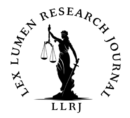Written by Sanya Srivastav,
Intern-Lex Lumen Research Journal,
June 2025
Introduction: The digital Mirror of Misogyny.
The digital realm that was imagined to be a transcendent space- open, anonymous and equal for all has yet again become a battleground for women and gendered minorities against patriarchal structures that not only replicates but also perpetuate patriarchal violence against women and gendered minorities. From deepfake pornography to casteist trolling, technologyfacilitated gender-based violence (TFGBV) is not just a digital nuisance but has now become a structural legal failure.
Online gender-based violence (GBV) is a permeating reality of digital spaces that bolsters the existing patriarchal structures and systemic inequalities against women. The women politicians in Asia pacific region face severe online abuse, which includes harassment, doxing, and rape threats etc.[1] All of these are deeply rooted in gendered hierarchies. This not only highlights how androcentric norms leverage technology to silence and marginalize women but also target women specifically active in public roles.
Online abuse against women politicians and journalists in India showcases how misogyny has deeply ingrained itself across platforms[2]. The abuse ranging from sexually explicit trolling to coordinated smear campaigns not only constrains women’s active engagement but also mirrors broader societal resistance to gender equality. This blog not only talks about TFGBV but also exposes how current laws and platform governance perpetuate harm by ignoring gendered power dynamics. It also underscores the importance of reclaiming cyberspace for women through restorative justice and accountability.
Understanding TFGBV & intersectionality: More Than Just “Online Harassment”
Technology-facilitated gender-based violence, or TFGBV, is a modern day manifestation of the patriarchal structure that strategically exploits online spaces to intimidate, threaten and silence women and gendered minorities .It is an act of violence perpetrated by one or more individuals that is committed, assisted, aggravated and amplified in part or fully by the use of information
and communication technologies or digital media, against a person on the basis of their gender[3]. It can also be defined as any action carried out using the internet and/or mobile technology that harms others based on their sexual or gender identity or by enforcing harmful gender norms[4].Far beyond the singular incidents of “online harassment”, TFGBV encompasses a wide spectrum of act that aims to harms a particular section which ranges from non-consensual intimate image sharing (NCII), cyber stalking, grooming, deepfake pornography, casteist trolling campaigns, doxxing, and coordinated hate speech5.
Gender based violence at its core thrives in the intersection of caste, colour, sexuality and religion. Many studies and researches have highlighted that women, members of LGBTQIA+ community face a disappropriate level TFGBV[5]. As per a UNESCO study black women journalists who belong to ethnic or racial minorities are disproportionately targeted with virtual hate speech and harassment ranging for racist to sexist comments. The same study juxtaposes white women journalists where they comparatively experience less TFGBV (64%) than their black counterpart who experience for about 81% of TFGBV[6].
Beyond these studies quotidian instances of TFGBV are enough to highlight the clutch these patriarchal structures have over online platforms. From a Dalit women facing cast based online sexual abuse to a Muslim women confronting Islamophobic harassment. The digital realm only perpetuates the offline hierarchies of gender, caste and class.
Online gendered violence is the modern-day witch hunt it burns no stakes, but scars are just as deep. The impact of TFGBV, that’s often ignored is not confined to an individual, it’s is psychological and collective. When faced with such violence that not only mentally disturbs also questions their right to dignity, the typical remedy given to the victims is to just LOGOUT that weaponizes TFGBV to exercise hegemony which eventually results in women and other gendered minorities to self-censor their online presence to avoid digital backlash
effectively pushing them out of the digital public places. Female journalists, politicians, social workers and influential personalities become perpetual victim of violence that is driven by the force to silence their voices and reinforce gender roles[7].
Despite the grave nature of the issues, the legal and technical gap remain unaddressed. The very interface structure of digital platform worsens the harm, Content filters that rely on artificial intelligence routinely miss threats written in local languages or fail to recognize harassment that uses culturally specific references[8]. At the same time, platforms’ obsession with maximizing engagement means their algorithms actively promote the most hateful, womanhating posts, turning individual attacks into massive harassment storms. What appears to be a random online cruelty is actually carefully targeted – the same groups that face discrimination in daily life become the focus of coordinated digital attacks. TFGBV isn’t monolithic, it mirrors and amplifies offline hierarchies. These intersections demand a legal framework that recognises their layered vulnerability.
The legal framework in India: patchwork or protection??
The gendered access gap in technology in India is not unintentional, it is premeditated and then enforced. The families restrict online access and the technological interface fail to design for safety. Gendered violence which is often trivialised or turned into victim blaming under patriarchal norms reflect that the current Indian legal system still treats technology facilitated gender-based violence as a part of cybercrime not as a standalone crime of gendered violence.
Indian response to online gender-based violence is like an old quilt, full of holes unable to provide any true security. OGBV is ruled by a patchwork of redundant laws that fail to grasp the realities of virtual harm or violence. Provisions of the information technology Act,2000 and IPC now BNS such section 66E10 , sec 6711of IT act, 2000 which deals with punishment for violation of privacy through capturing, publishing private pictures without consent and publication of obscene material in electronic form respectively, and section 509 of IPC now section 79 of BNS[9] which deals with insulting the modesty of women are invoked in cases of
online abuse however these laws are not designed to counter the gendered nature of online violence.
From lack of civil remedies for immediate content removal or victim compensation and lack of Reporting mechanisms exclude non-English speakers and rural women, making justice inaccessible to Psychological and reputational harm. The flaws of Indian legal system are overtly present and they become more apparent in comparison with other more progressive countries. UK’s online safety act places a legal duty on tech companies to identify and remove content that facilitates abuse, including threats, harassment, and the sharing of non-consensual intimate images. It also empowers the regulator, Ofcom, to hold companies accountable if they fail to protect users from gender-based violence online[10]. The safe spaces act of Philippines explicitly includes online spaces in its safe spaces act[11].
The current legal framework India addressing online gender-based violence operate within regressive a paradigm ignorant of the intersectional realities. In the absence of any structural and significant changes that specifically address online gender-based violence, the digital future of women and gendered minorities remain bleak and will continue to be so until a law that treats online gender-based violence as a separate crime against community rather than a part of cybercrime is enacted.
“Firewalling the Future: Recommendations for Online Safety”
In order to effectively address the critical matter of online gender-based violence, India must adopt a holistic strategy addressing legal, technological, and social aspects. The first priority should be to enact a legislation that explicitly recognises gender-based violence as a separate crime against community and which penalises various digital gender crimes right from AIgenerated abuse to caste-based cyber harassment and incorporates civil remedies for immediate content removal and compensation. The role of social Media companies cannot be ignored as it becomes imperative to hold the digital platform accountable and enforce a set of regulations that would require them to develop culturally aware AI-moderation system capable of detecting abuse patterns, create localised response teams with strict resolution timelines and also contribute to survivors’ compensation pool.
Community too should play an active role in the eradication of the issue. Multilingual support helplines along with professionally trauma trained responders can be established. Various collaborative platform with grassroots gender rights organisations should be promoted along with mental health services tailored according to the need of online abuse survivors. Law enforcement needs specialized cyber units focused on gender crimes, staffed with sensitized personnel. Regular audits of platform algorithms must take place to detect and correct biases that intensify abusive content. Meanwhile in the interim, there must amendments made in cyber crime and information technology act to recognize online gendered violence as a standalone crime and take preventative as well as reactive measures.
Comprehensive digital safety can only be achieved by reconstructing both technological as wells as social perception instead of curtailing women’s digital autonomy. The androcentric system must be dismantled from its core to revive internet as an emancipatory space
Conclusion – A call for Digital Reckoning
The internet’s commitment towards autonomy has been fractured by the same androcentric forces it was designed to surpass. TFGBV,
The internet’s promise of autonomy has been deceived by the same patriarchal forces it was meant to transcend. Technology-facilitated violence, reflects not just individual acts of savagery, but acts of digital authoritarianism. Substantive transformation demands fundamental reconceptualization statutes that address online abuse as gender terrorism, platforms refashioned for security over engagement, and justice systems that prioritize dignity over outdated notions of “honour.” This isn’t about making the internet safer, it’s about dismantling digital patriarchy itself. The fight for online equality is the fight for our collective future.
[1] Inter-parliamentary union, https://www.ipu.org/news/press–releases/2025–03/60–women–mps–asia–pacificreport–online–gender–based–violence? (19th June 2025)
[2] Amnesty international USA, https://www.amnestyusa.org/press–releases/shocking–scale–of–abuse–on–twitteragainst–women–politicians–in–india/ (19th June 2025)
[3] United Nations Population Fund, https://www.unfpa.org/resources/brochure–what–technology–facilitatedgender–based–violence ,(19th June 2025)
[4] Laura Hinson, Jennifer Mueller, Lila O’Brien-Milne and Naome Wandera, . Technology-facilitated genderbased violence: What is it, and how do we measure it?, International center for research on women, page no.1, https://www.icrw.org/wp–content/uploads/2018/07/ICRW_TFGBVMarketing_Brief_v8–Web.pdf , 2018 5 UN women, https://www.unwomen.org/en/articles/faqs/digital–abuse–trolling–stalking–and–other–forms–oftechnology–facilitated–violence–against–women , (20th June 2025)
[5] Centre for international governance innovation, https://www.cigionline.org/publications/supporting–saferdigital–spaces/ , (20th June 2025)
[6] Julie PosettiNabeelah Shabbir Diana Maynard Kalina Bontcheva Nermine Aboulez, The Chilling: Global trends in online violence against women journalists, UNESCO, https://unesdoc.unesco.org/ark:/48223/pf0000377223/PDF/377223eng.pdf.multi ,page no.22, 2025.
[7] International women’s media foundation, https://www.iwmf.org/2021/02/gender–based–violence–againstfemale–journalists–harassment–should–never–be–part–of–the–job/ , 920th June 2025)
[8] Content-filtering AI systems–limitations, challenges and regulatory approaches
Althaf Marsoof,Andrés Luco,Harry Tan &Shafiq Joty, Content-filtering AI systems–limitations, challenges and regulatory approaches, Taylor & Francis online, https://doi.org/10.1080/13600834.2022.2078395 , 2022 10 Information technology, 2000, § 66E, No. 21, Acts of Parliament ,2000 (India). 11 Information technology, 2000, § 67, No. 21, Acts of Parliament ,2000 (India).
[9] Bhartiya Nyaya Sanhita, 2023, § 79, (India)
[10] Ofcom, https://www.ofcom.org.uk/online–safety/illegal–and–harmful–content/time–for–tech–firms–to–act–ukonline–safety–regulation–comes–into–force , (20th June 2025)
[11] Philippine commission on women, https://pcw.gov.ph/faq–republic–act–no–11313/ , (20th June 2025)


